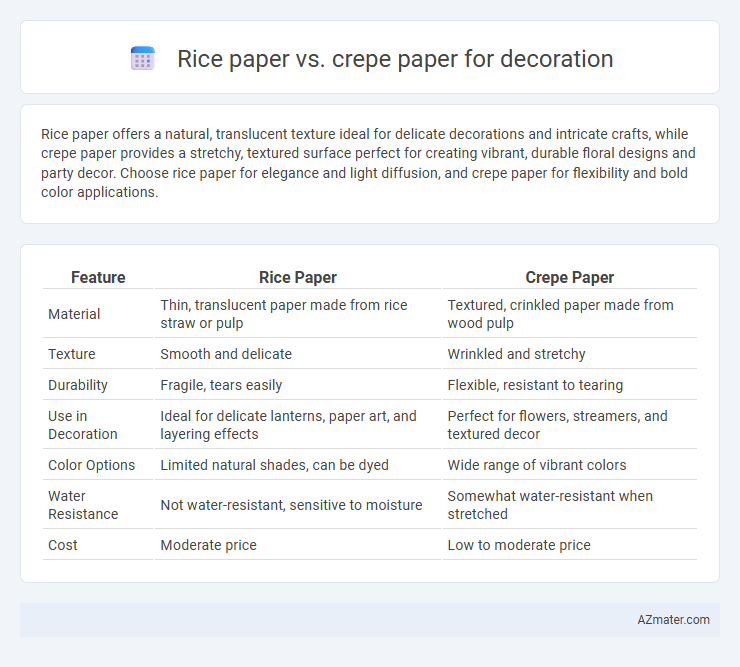Rice paper offers a natural, translucent texture ideal for delicate decorations and intricate crafts, while crepe paper provides a stretchy, textured surface perfect for creating vibrant, durable floral designs and party decor. Choose rice paper for elegance and light diffusion, and crepe paper for flexibility and bold color applications.
Table of Comparison
| Feature | Rice Paper | Crepe Paper |
|---|---|---|
| Material | Thin, translucent paper made from rice straw or pulp | Textured, crinkled paper made from wood pulp |
| Texture | Smooth and delicate | Wrinkled and stretchy |
| Durability | Fragile, tears easily | Flexible, resistant to tearing |
| Use in Decoration | Ideal for delicate lanterns, paper art, and layering effects | Perfect for flowers, streamers, and textured decor |
| Color Options | Limited natural shades, can be dyed | Wide range of vibrant colors |
| Water Resistance | Not water-resistant, sensitive to moisture | Somewhat water-resistant when stretched |
| Cost | Moderate price | Low to moderate price |
Introduction to Rice Paper and Crepe Paper
Rice paper is a thin, translucent material made from the pith of the rice plant, prized for its delicate texture and smooth surface, often used in intricate paper crafts and decorations. Crepe paper, created by coating thin paper with sizing and then crinkling it, offers a textured, stretchable quality ideal for vibrant, dimensional floral decorations and party decor. Both materials serve distinct purposes in decoration, with rice paper favored for fine detail and crepe paper for bold, textured effects.
Key Characteristics of Rice Paper
Rice paper features a translucent, delicate texture that adds an elegant, lightweight touch to decorations, making it ideal for intricate designs and layering effects. Its absorbent quality allows vibrant inks and dyes to create sharp, vivid patterns without bleeding, enhancing visual appeal. Unlike crepe paper, rice paper is more fragile and less stretchable, offering a unique tactile aesthetic suited for refined decorative projects.
Key Characteristics of Crepe Paper
Crepe paper features a distinctive crinkled texture that provides flexibility and stretch, making it ideal for creating lifelike flowers and intricate decorations. Its lightweight yet durable composition holds shapes well, allowing for detailed crafting and easy manipulation. Unlike rice paper, crepe paper is less translucent but offers vibrant colors and a more resilient surface, enhancing its suitability for festive and long-lasting decorative projects.
Visual Differences: Texture and Appearance
Rice paper features a smooth, translucent texture with a delicate, slightly glossy finish that enhances intricate designs and provides a subtle elegance in decoration. Crepe paper showcases a crinkled, matte surface with pronounced ridges, offering a rich texture that adds volume and depth to floral arrangements and other decorative crafts. The visual difference lies in rice paper's refined smoothness and translucency versus crepe paper's textured, opaque, and dynamic appearance.
Strength and Durability Comparison
Rice paper, known for its delicate texture and translucent quality, offers moderate strength but tends to tear easily under stress, making it less durable for heavy-duty decoration. Crepe paper, crafted with a crinkled texture and thicker fibers, provides superior strength and flexibility, allowing it to withstand bending and shaping without ripping. For long-lasting decorations that require resilience and repeated handling, crepe paper is the more durable and robust choice compared to fragile rice paper.
Versatility in Craft and Decoration Projects
Rice paper offers exceptional translucency and delicate texture, making it ideal for intricate lanterns and layered art projects, while crepe paper excels in flexibility and stretchability, perfect for creating realistic flowers and textured decorations. Both materials support a wide range of crafting techniques, including folding, tearing, and gluing, but crepe paper's durability under manipulation often gives it an edge for three-dimensional decorations. The choice between rice paper and crepe paper ultimately depends on the desired aesthetic and the structural demands of the decoration project.
Color Availability and Customization Options
Rice paper offers limited color availability typically in soft, natural hues, making it ideal for subtle, elegant decorations, while crepe paper boasts a wide spectrum of vibrant colors suitable for bold and dynamic designs. Customization options for rice paper are generally restricted due to its delicate texture, whereas crepe paper allows for extensive manipulation, including cutting, folding, and shaping, enabling diverse decorative possibilities. Crepe paper's flexible nature also supports dyeing and painting, expanding creative color customization beyond pre-manufactured options.
Ease of Use for Beginners and Experts
Rice paper offers a smooth surface that is easy for beginners to cut and shape, making it ideal for simple decorative projects, while experts can leverage its translucency for intricate layering effects. Crepe paper's textured, stretchy quality allows both novices and experienced decorators to create dynamic, lifelike flowers and ruffles with greater flexibility and durability. For ease of use, rice paper excels in handling precise folds and clean edges, whereas crepe paper is more forgiving during manipulation and resists tearing under repeated adjustments.
Cost and Accessibility of Both Papers
Rice paper tends to be more expensive and less accessible than crepe paper due to its delicate manufacturing process and limited availability in craft stores. Crepe paper is widely available, affordable, and comes in a variety of colors and textures, making it the preferred choice for large decoration projects on a budget. When considering cost-effectiveness and ease of purchase, crepe paper offers better accessibility for decorative purposes.
Best Applications: Choosing the Right Paper for Your Decoration
Rice paper offers a delicate, translucent texture ideal for elegant lanterns, floral arrangements, and intricate paper crafts that require subtle light diffusion. Crepe paper features a crinkled, stretchable surface perfect for creating vibrant, lifelike flowers, garlands, and textured decorations that demand flexibility and volume. Selecting the right paper depends on whether the project prioritizes translucency and finesse with rice paper or bold colors and durability with crepe paper.

Infographic: Rice paper vs Crepe paper for Decoration
 azmater.com
azmater.com